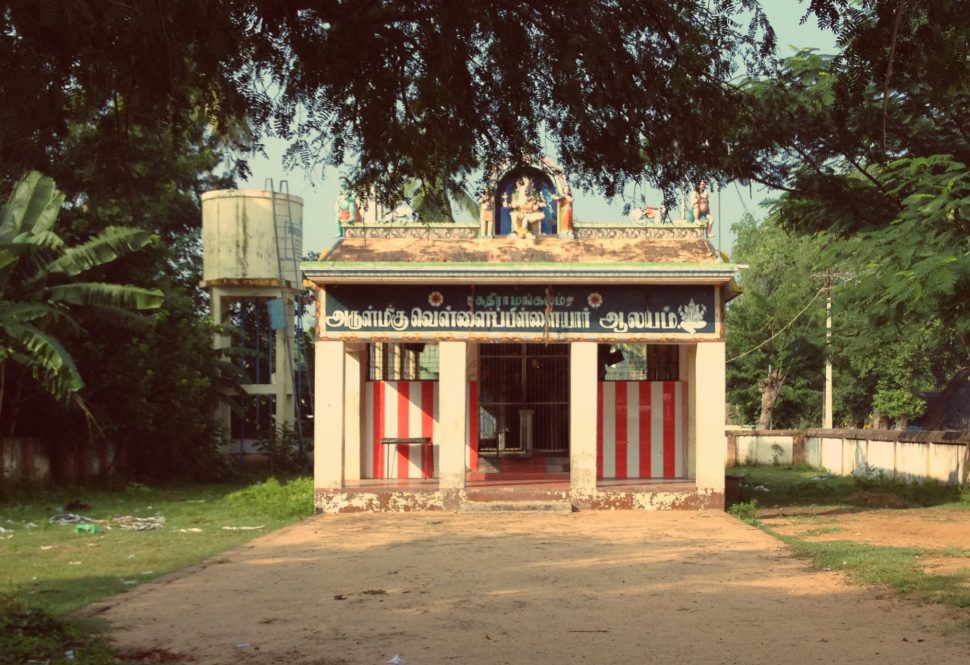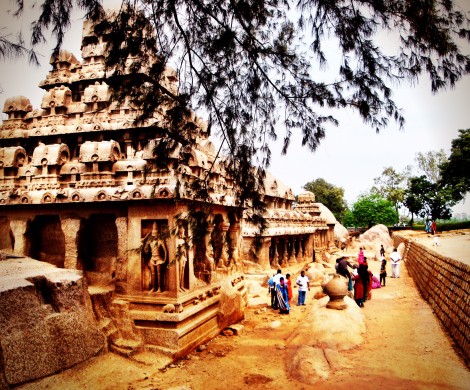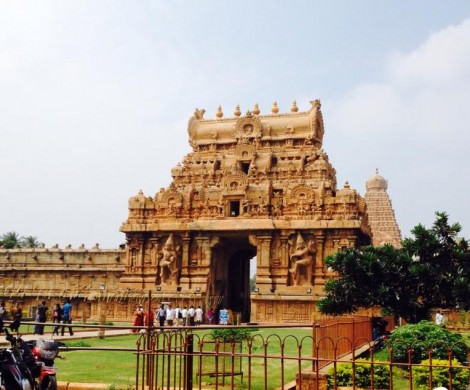
Grand Uncle Subbu sent me the article and I realised that for me, this tree went back 11 generations! I also found out that the primary reason for the article had been to highlight to the various branches of the family, the decaying state of the temple established by our ancestors in the village of Kadiramangalam, and to raise funds for its revival. The temple, dedicated to Lord Ganesha was known as the ‘Vellai Pillaiyar’ (White Ganesha) temple.
The village of Kadiramangalam in Tanjore had been given as a ‘jagir‘ (grant) to my ancestors by a Maratha King. According to the research done by Mr.Murali, Uncle Subbu’s nephew, he estimates this was possibly in the time of Serfoji II (1777 – 1832) who valued learning and scholarship. The family tree in the article goes back up 11 generations to a Ganapathy Subbaiyer, a great scholar and devotee of Lord Ganesha, and his son Ramaswamy Iyer (I) who was the Dewan in the court of Tanjore’s Maratha King.
Mr.Murali’s grandfather had handwritten the first version of the family tree in Tamil sometime in the late ’70s. He sent us a more modern, e-version (image below).

A simple genealogy in English
1. Ganapathy Subbaiyer – The forebear
2. K. Ramaswamy Iyer, Dewan of Tanjore during Maratha days
3. Chinna Appu Iyer
4. Peria Rama Iyer
5. Krishna Iyer
6. K. Ramaswamy Iyer – My maternal grandmother’s grandfather
Through my maternal grandmother, I descend from No.6 after 4 generations.
Ever since my discovery of this aspect of my history, I have wanted to visit Kadiramangalam. I even promised Uncle Subbu that we would go there together. That was in 2007. Life took over and nothing ever came of that promise.
Till November 2013, nearly 6 years later when I embarked on the ‘Journey 2 Roots’ trip with my parents. When Uncle Subbu found out we were going to Mayavaram, which is a 30-minute drive from Kadiramangalam, he decided to come along, even though he is 80!
(Part 1 of #journey2roots here.)
On the train journey from Bangalore to Mayavaram, Uncle Subbu gave me more details of what he remembered as a young boy, of Kadiramangalam, when his grandfather, K.Ramaswamy Iyer, BA, BL (not to be confused with the Dewan) still lived there with his brothers. Known as the Viswanathan Kovil street agraharam, it used to be at the centre of around 150+ houses. Over the years, the agraharam receded and the various descendants of Ramaswamy Iyer II left the village for bigger pastures, and the house, as well as the temple fell into disrepair.

A priest who was also the caretaker of the family temple was living there till about ten years ago, and the roof was already disintegrating at the time. During our trip, we couldn’t locate it and I am pretty sure it’s long gone.
Every temple in the Vedic tradition houses the main deity in the sanctum sanctorum and that deity is fixed to a single spot and is called the Moola Vigraha. Vedic tradition provides the option to have a smaller form of the main deity, known as the Utsava Murthi that can be decorated and taken out for processions and other festivities. The Utsava Murthi of the Vellai Pillayar temple is kept for safe keeping at the Hindu Religious and Charitable Endowments of the Tamilnadu Government. (There have been many cases of ancient idols being stolen from historic temples by thieves and other pilferers). Apparently, below the Utasava Moorthy are the words “Tiruvennainallur Vellai Pillayar” in Tamil. Tiruvennainallur was the ancient name of Kadiramangalam and it is believed that the original idol (moola vigraha) was consecrated by Sage Kamban, a medieval Tamil Poet and author of the Tamil version of the Ramayana, who grew up in Thiruvennainallur, and my ancestors built the temple over this idol.
When Mr.Murali reached out to the various branches of the family to raise funds for his ambitious revival project, I contributed as well. A ‘mahakumbhabhishekam‘ was performed in 2008 and the temple was open once more.


Five years later, 3 generations of K.Ramaswamy Iyer’s descendants– my mom, my grand uncle and I, walked in his footsteps and visited the temple established by our forefathers. It’s small, simple and relatively bare, with an inexplicable Shivaling (an iconic representation of the Hindu deity, Lord Shiva) outside, but it’s functional and people still seem to visit, though when we were there, the place was deserted.



While we were there, a bunch of kids from the huts across the street ran into the temple compound to gawk at us ‘city people’. The little girl informed me that her name was G.Arti, though on her arm she had a henna tattoo that said Lavanya in Tamil. When I asked about that, she looked at me like I was a particularly slow child and told me it was her best friend’s name. I was suitably chastised for not knowing the obvious and went on to tell her, that she shared her name with my sister. That sealed our friendship and she agreed to be photographed.


Arti told us the priest was at the Vana Durga temple down the road, from where we had just come, which was a sister temple to this one.
Mr.Murali’s article says Vana Durga is the Kula Deivam of the family while Vellai Pillayar is the Graha Deivam. Kula Deivam is a temple for a particular sect of people in a village. Graha Deivam is a deity worshipped in your House.
She also knowledgeably informed us that the white marble Ganesha idol was stolen many, many decades ago and while the current idol is made of black stone, the name ‘Vellai Pillayar’ stuck. Obviously, this story doesn’t find a place in Mr.Murali’s historical article and I have no idea if there is any truth to it, but a story is a story and all angles must be covered!
My mother’s grandfather, R.Atmaraman Iyer, son of K.Ramaswamy Iyer left Kadiramangalam at some stage and lived in Nannilam, a village around 30km from Mayavaram with his wife Mangalam (known as Manni Paati to everyone). That’s where my grandma and her siblings including Uncle Subbu were born.

Unfortunately, we couldn’t visit Nannilam as part of this trip due to time constraints. Uncle Subbu had many stories about his father, who was apparently quite a colourful character in his time. My mom was supposedly his favorite grandchild and Uncle Subbu told me how the old man, never known for his generosity, surprised everyone by bringing her little gifts whenever she visited. My mom remembers how ahead of his times he was, paying the neighbourhood kids to clean up his fields for every x amount of rubbish they collected. Manni Paati lived to a grand old age and I remember her only as the Paati in a madisar sari and very thick glasses, who took her teeth out every now and then, which freaked me out as a kid.
This journey to discover my roots has been quite an experience. I don’t know what I expected when I set out on it. But seeing the kind of places my forebears came from, I am thankful for everything I have today. I wish I knew more about their lives and the kind of people they were, because what little I know barely scratches the surface. With each new generation, we lose just a little bit more of the past, a history that has shaped the lives that we were eventually born into. I don’t know if that helps us make better choices for the future, but I certainly know that this journey into history has given me perspective. And by documenting it, I hope it helps someone else one day, understand a little bit about how far they have come.

